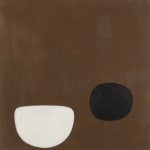William Scott 1913-1989
White, Brown and Black, 1979
oil on canvas
50 x 50 cm
19 3/4 x 19 3/4 in
19 3/4 x 19 3/4 in
signed verso
'I find beauty in plainness, in a conception which is precise ... a simple idea which to the observer in its intensity must inevitably shock and leave a concrete image...
'I find beauty in plainness, in a conception which is precise ... a simple idea which to the observer in its intensity must inevitably shock and leave a concrete image in the mind'. (William Scott, 1947)
Scott was part of a pioneering group of post-war British artists, including Patrick Heron and Peter Lanyon who were challenging academic tradition and at the forefront of British abstraction in the 1950s. These artists shared a dialogue with their counterparts in the United States, including Rothko, de Kooning and Pollock. During Scott's first visit to New York in 1953, he was introduced by the gallerist Martha Jackson to some of the city’s most prominent artists. Six years later Rothko returned the visit, staying with Scott in Somerset. Marther Jackson went on to exhibit his work alongside Francis Bacon and Barbara Hepworth in 1954 followed by several solo shows over the following years. Jackson was introduced to Scott’s work by James Sweeney, the influential curator of MoMA who said of Scott: “At last, England has a painter!” However, despite his interest in abstraction, Scott remained committed to his own painterly language and never abandoned representation. Rather, his work reflects a delicate balance between the abstraction of American Abstract Expressionism and the more figurative Modernism of Europe.
Scott's continued engagement with the still-life subject throughout his career was a means by which he could explore form, colour and space. By the 1970s, the isolated domestic objects - pans, plates and saucepans were simplified into flat, elemental shapes placed against subtly modulated grounds and the spatial relationships between these forms have become more ambiguous and intense. In the present work, the forms are reduced to their bare minimum, the black form placed with meticulous precision to be in perfect balance with the white form. The surface of the work, at first appears smooth and crisp but closer engagement reveals a painterly surface with subtle variations in the tone. There is a soft diffusion to the form of the objects and the glow to their edges lifts their silhouetted forms from the rich surface. The result is a deceptively simple, yet arresting image where form, space and surface have achieved a new equilibrium.
Scott was part of a pioneering group of post-war British artists, including Patrick Heron and Peter Lanyon who were challenging academic tradition and at the forefront of British abstraction in the 1950s. These artists shared a dialogue with their counterparts in the United States, including Rothko, de Kooning and Pollock. During Scott's first visit to New York in 1953, he was introduced by the gallerist Martha Jackson to some of the city’s most prominent artists. Six years later Rothko returned the visit, staying with Scott in Somerset. Marther Jackson went on to exhibit his work alongside Francis Bacon and Barbara Hepworth in 1954 followed by several solo shows over the following years. Jackson was introduced to Scott’s work by James Sweeney, the influential curator of MoMA who said of Scott: “At last, England has a painter!” However, despite his interest in abstraction, Scott remained committed to his own painterly language and never abandoned representation. Rather, his work reflects a delicate balance between the abstraction of American Abstract Expressionism and the more figurative Modernism of Europe.
Scott's continued engagement with the still-life subject throughout his career was a means by which he could explore form, colour and space. By the 1970s, the isolated domestic objects - pans, plates and saucepans were simplified into flat, elemental shapes placed against subtly modulated grounds and the spatial relationships between these forms have become more ambiguous and intense. In the present work, the forms are reduced to their bare minimum, the black form placed with meticulous precision to be in perfect balance with the white form. The surface of the work, at first appears smooth and crisp but closer engagement reveals a painterly surface with subtle variations in the tone. There is a soft diffusion to the form of the objects and the glow to their edges lifts their silhouetted forms from the rich surface. The result is a deceptively simple, yet arresting image where form, space and surface have achieved a new equilibrium.
Provenance
William ScottGallery Moos, Canada, 1979
Offer Waterman & Co, London
Private Collection, UK
Exhibitions
Toronto, Gallery Moos, William Scott, 1979 solo exhibitionLiterature
Sarah Whitfield ed., William Scott, Catalogue Raisonne of Oil Paintings, vol.4, London, Thames and Hudson, 2013, cat. no.866, illustratedPublications
William Scott Foundation, number WS866Join Our Mailing List
We won't spam you. We will send a monthly email highlighting new artworks and events, with very occasional other mailings.
* denotes required fields
In order to respond to your enquiry, we will process the personal data you have supplied in accordance with our privacy policy. You can unsubscribe or change your preferences at any time by clicking the link in any emails.



